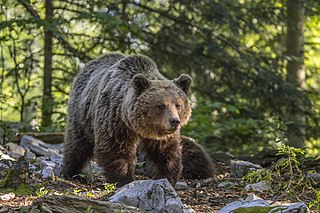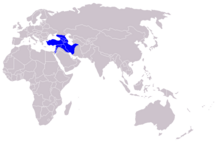
The brown bear is a large bear species found across Eurasia and North America. It is one of the largest living terrestrial members of the order Carnivora, rivaled in size only by its closest relative, the polar bear, which is much less variable in size and slightly bigger on average. Adults of different subspecies range in weight from 80 to 600 kg, with males being heavier than females. Despite its name, brown bears aren't entirely brown; the pelage can be reddish to yellowish-brown, and dark brown to cream in color. During winter, brown bears in some populations hibernate and emerge during spring to regain up to 180 kg (400 lb) of weight. They have well developed dentition and claws, ideal for their lifestyle.

The Atlas bear or North African bear was a population of brown bear native to North Africa that became extinct in historical times.

The Eurasian brown bear is one of the most common subspecies of the brown bear, and is found in much of Eurasia. It is also called the European brown bear, common brown bear, common bear, and colloquially by many other names. The genetic diversity of present-day brown bears has been extensively studied over the years and appears to be geographically structured into five main clades based upon analysis of the mtDNA.

The Zagros Mountains forest steppe is a temperate broadleaf and mixed forests ecoregion in Western Asia. The ecoregion extends along the Zagros Mountains, stretching from eastern Turkey and northern Iraq to southern Iran.

Fauna in Armenia is diverse given the country's relatively small geographic size, owing to the varied habitats created by the area's mountainous terrain. Armenia is an important area for migratory animals; about 350 different bird species were recorded in the country. Many of the world's domesticated animals originated in the area Armenia is located in, and the mouflon, the ancestor of domesticated sheep, is present there. Research suggests that about a quarter of the animal species in Armenia are internationally endangered. The mouflons are suffering a great population decline due to poaching and habitat loss, and the Sevan trout, which made up thirty percent of the fish in Lake Sevan, have virtually disappeared.

The Himalayan brown bear, also known as the Himalayan red bear or isabelline bear, is a subspecies of the brown bear occurring in the western Himalayas. It is the largest mammal in the region, males reaching up to 2.2 m long, while females are a little smaller. It is omnivorous and hibernates in dens during the winter.

The Caucasus mixed forests is a temperate broadleaf and mixed forests ecoregion in the Caucasus Mountains, as well as the adjacent Lesser Caucasus range and the eastern end of the Pontic Mountains.

The Eastern Mediterranean conifer-sclerophyllous-forests, also known as the Eastern Mediterranean conifer-forests, is an ecoregion in the eastern Mediterranean Basin. It covers portions of Turkey, Syria, Iraq, Lebanon, Israel, Palestinian territories, Jordan, and Saudi Arabia.
The wildlife of Iran include the fauna and flora of Iran.

Panthera pardus tulliana, also called Anatolian leopard, Persian leopard and Asia Minor leopard, is a leopard subspecies that was first described in 1856 based on a zoological specimen found in western Anatolia. It is native to the Iranian Plateau and the surrounding region from eastern Anatolia and the Caucasus to the Hindu Kush, where it inhabits foremost subalpine meadows, temperate broadleaf and mixed forests and rugged ravines at elevations of 600 to 3,800 m. It preys mostly on ungulates reliant on these habitats.

The wildlife of Armenia includes, in addition to plants, wild boars, porcupines, various lizards, snakes and numerous species of birds. Endangered species living in Armenia are the Caucasian bear, Caucasian bearded goat, the Armenian mouflon (sheep) and the leopard.

The Gobi bear, known in Mongolian as the Mazaalai (Мазаалай), is a subspecies of the brown bear that is found in the Gobi Desert of Mongolia. It is listed as critically endangered by the Mongolian Redbook of Endangered Species and by IUCN standards. Currently, there are only 31 bears left in the Mongolian Gobi Desert; through long-term genetic monitoring it is known that the population is relatively stable, however, the sex ratio is highly skewed towards males. Gobi bears are separated by enough distance from other brown bear populations to achieve reproductive isolation. In 1959, hunting of the animal was prohibited in order to preserve the dying subspecies.

The Marsican brown bear, also known as the Apennine brown bear, and orso bruno marsicano in Italian, is a critically endangered population of the Eurasian brown bear, with a range restricted to the Parco Nazionale d'Abruzzo, Lazio e Molise, and the surrounding region in Italy. The Marsican brown bear differs slightly from other brown bears in its appearance and hibernation techniques. The bear's popular name is derived from Marsica, a historic area of the modern-day region of Abruzzo where the bear has long had a significant presence.

The Mexican grizzly bear is an extinct population of the grizzly bear in Mexico.

Bear hunting is the act of hunting bears. Bear have been hunted since prehistoric times for their meat and fur. In addition to being a source of food, in modern times they have been favored by big game hunters due to their size and ferocity. Bear hunting has a vast history throughout Europe and North America, and hunting practices have varied based on location and type of bear.

The Cantabrian brown bear, Iberian brown bear, or Iberian bear is a population of Eurasian brown bears living in the Cantabrian Mountains of Spain.

The Elburz Range forest steppe ecoregion is an arid, mountainous 1,000-kilometer arc south of the Caspian Sea, stretching across northern Iran from the Azerbaijan border to near the Turkmenistan border. It covers 63,300 square kilometres (24,400 sq mi) and encompasses the southern and eastern slopes of the Alborz Mountains as well as their summits. The Caspian Hyrcanian mixed forests ecoregion's lush green mountainsides and plains receive moisture from the Caspian Sea from this ecoregion's northern border. The vast Central Persian desert basins ecoregion forms its southern border.

The Hyrcanian forests are a zone of lush lowland and montane forests covering about 55,000 square kilometres (21,000 sq mi) near the shores of the Caspian Sea in Iran and Azerbaijan. The forest is named after the ancient region of Hyrcania. The World Wide Fund for Nature refers to the ecoregion as the Caspian Hyrcanian mixed forests. Since 5 July 2019, the Hyrcanian Forests have been designated a UNESCO World Heritage Site. In September 2023, the heritage site expanded to incorporate portions of the forest located in Azerbaijan.
Formerly or currently considered subspecies or populations of brown bears have been listed as follows:





















